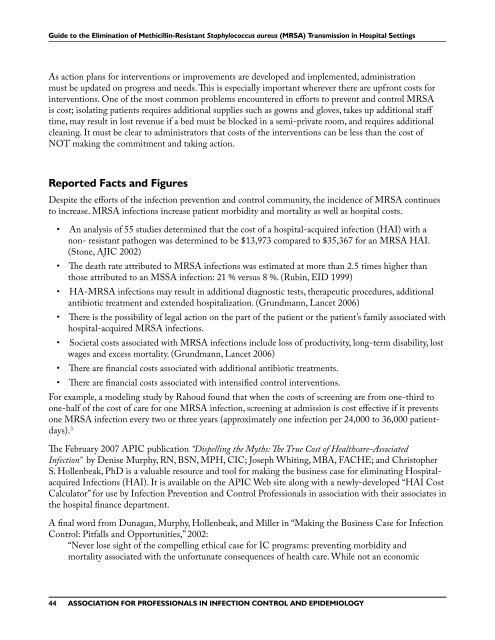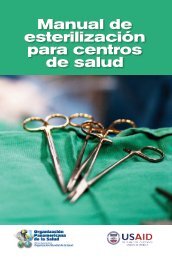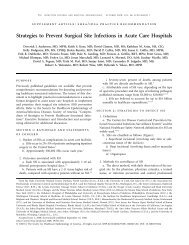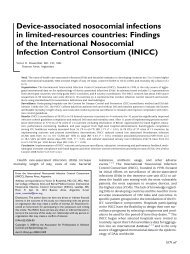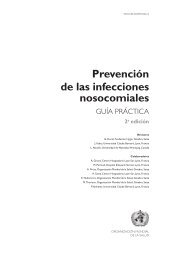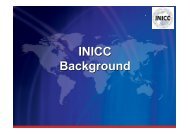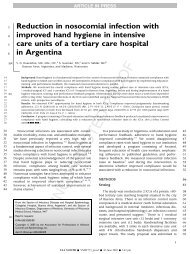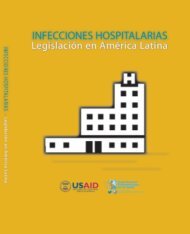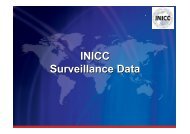APIC MRSA Elimination Guideline
APIC MRSA Elimination Guideline
APIC MRSA Elimination Guideline
Create successful ePaper yourself
Turn your PDF publications into a flip-book with our unique Google optimized e-Paper software.
Guide to the <strong>Elimination</strong> of Methicillin-Resistant Staphylococcus aureus (<strong>MRSA</strong>) Transmission in Hospital SettingsAs action plans for interventions or improvements are developed and implemented, administrationmust be updated on progress and needs. This is especially important wherever there are upfront costs forinterventions. One of the most common problems encountered in efforts to prevent and control <strong>MRSA</strong>is cost; isolating patients requires additional supplies such as gowns and gloves, takes up additional stafftime, may result in lost revenue if a bed must be blocked in a semi-private room, and requires additionalcleaning. It must be clear to administrators that costs of the interventions can be less than the cost ofNOT making the commitment and taking action.Reported Facts and FiguresDespite the efforts of the infection prevention and control community, the incidence of <strong>MRSA</strong> continuesto increase. <strong>MRSA</strong> infections increase patient morbidity and mortality as well as hospital costs.• An analysis of 55 studies determined that the cost of a hospital-acquired infection (HAI) with anon- resistant pathogen was determined to be $13,973 compared to $35,367 for an <strong>MRSA</strong> HAI.(Stone, AJIC 2002)• The death rate attributed to <strong>MRSA</strong> infections was estimated at more than 2.5 times higher thanthose attributed to an MSSA infection: 21 % versus 8 %. (Rubin, EID 1999)• HA-<strong>MRSA</strong> infections may result in additional diagnostic tests, therapeutic procedures, additionalantibiotic treatment and extended hospitalization. (Grundmann, Lancet 2006)• There is the possibility of legal action on the part of the patient or the patient’s family associated withhospital-acquired <strong>MRSA</strong> infections.• Societal costs associated with <strong>MRSA</strong> infections include loss of productivity, long-term disability, lostwages and excess mortality. (Grundmann, Lancet 2006)• There are financial costs associated with additional antibiotic treatments.• There are financial costs associated with intensified control interventions.For example, a modeling study by Rahoud found that when the costs of screening are from one-third toone-half of the cost of care for one <strong>MRSA</strong> infection, screening at admission is cost effective if it preventsone <strong>MRSA</strong> infection every two or three years (approximately one infection per 24,000 to 36,000 patientdays).3The February 2007 <strong>APIC</strong> publication “Dispelling the Myths: The True Cost of Healthcare-AssociatedInfection” by Denise Murphy, RN, BSN, MPH, CIC; Joseph Whiting, MBA, FACHE; and ChristopherS. Hollenbeak, PhD is a valuable resource and tool for making the business case for eliminating HospitalacquiredInfections (HAI). It is available on the <strong>APIC</strong> Web site along with a newly-developed “HAI CostCalculator” for use by Infection Prevention and Control Professionals in association with their associates inthe hospital finance department.A final word from Dunagan, Murphy, Hollenbeak, and Miller in “Making the Business Case for InfectionControl: Pitfalls and Opportunities,” 2002:“Never lose sight of the compelling ethical case for IC programs: preventing morbidity andmortality associated with the unfortunate consequences of health care. While not an economic44ASSOCIATION FOR PROFESSIONALS IN INFECTION CONTROL AND EPIDEMIOLOGY


